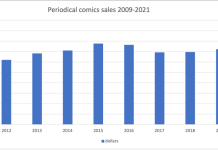Editors note: First off, the campaign has reached its goal! YAY! But keep giving. Second I (Heidi) wrote IndieGogo in stead of GoFundMe. Apologies for the error. We’ve fixed the references.)
Books with Pictures is one of Portland’s comics institutions, a comics shop but much more. It’s won an Eisner Award. It’s spun off into a sister shop, Books With Pictures Eugene. It throws an annual mini-con. BWPCon, now running for four years. They’ve opened a Pop-Up shop as part of an effort to revitalize Portland’s downtown.
Owner Katie Pryde is one of the main drivers behind the essential ComicsPRO’s Comet Standard metadata project. She’s on the board of ComicsPRO, and the Northwest Museum of Cartoon Arts. I’ve spoken with Katie many times and she’s a dynamo who is totally invested in comics and the world of comics.
I’ve been to the shop and it’s a stunner. Books With Pictures is a mission-driven business and also a vital part of the community.
But that doesn’t mean the store has been making enough money to pay the bills. As laid out in an GoFundMe campaign, the shop has been struggling in the current maelstrom of comics events. Katie is an excellent writer so you should read the whole thing, but here’s the problem:
Running a comics shop is hard. In some ways, it is hard in the way that all brick-and-mortar small business is hard: there is often a cheaper alternative online, we are never able to pay our staff as well as they deserve, unavoidable costs go up every year, and the bizarre economics of the present moment make everything uncertain. And it is also hard in unique ways: nearly all of our products have prices fixed by their publishers, so that we can’t just hike the cost of risotto when we need a better profit margin. We handle an almost unmatched number of new SKUs every week, requiring unique software and a great deal of hands-on work hours. Disruptions in distribution over the past handful of years have made every week feel like it has held a new crisis in data management, shipping dates, or the nuances of ordering products. Ordering timelines can vary from three weeks out to three months out, and can ship on schedules so variable that budgeting for each week or month’s product cost is virtually impossible: sometimes there is a trickle, and sometimes there is a flood. And of course, for reasons that continue to mystify me, sometimes the customers just don’t come in.Books with Pictures is a comics store unlike any other, and there are challenges that come with that too. We’re not just serving traditionally underrepresented comics audiences, we’re trying to nurture them and grow them. If we were the sort of store that put the bulk of our resources into selling high-priced variants and slabs to speculators, we’d be having an easier time of it. But what we care about is readers, and finding comics for everyone to read and love–and that means we’re doing this on Hard Mode.












This is such a wild ask that I feel like I need to give some push back. While I’m glad people really like Katie and her “mission”, all she’s doing is describing a system that all other comic shops have to go through and, strangely, none of them need to set up a fundraiser, let alone their second one (the first was to buy the building BWP is currently in).
Portland has many, many comic shops. BWP is one of them and it is fine. The space is small and they have a variety of books but there isn’t a whole lot to set them apart from all the other shops in the city. These other shops are also invested in growing the community and will also help you find something you may like. What I’m saying here is that BWP isn’t exactly a lone shining light in a dark, comics-free desert. There’s a lot of local competition.
Donate to BWP or not but I suspect there will be yet another fundraiser in a few years. After all, Katie is openly admitting that she knows how she could make money and is purposely not doing that. It’s great idealism but poor business management.
“There’s a lot to say about how running a store that doesn’t sell collector bait variants and slabs had a hard time showing a profit, but here we are indeed. An essay for tomorrow perhaps.” You should definitely write this and have retailers explain variants. I know the “V-word” is a giant boogeyman to comics-readers and the economics of why they exist, how much money they actually bring in, and if they’re really a herald of doom would be an interesting read.
BREAKING NEWS: Dude on Internet Feels Obligated to Express Contrary Opinion About Woman’s Article on Woman’s Store.
Come on, man – the quoted text is just two paragraphs long, and it seems like you didn’t even read the second one.
Any business’s resources are finite. Katie has chosen to expend hers on community building efforts, reaching out to and cultivating new comics audiences, and specifically creating a welcoming environment for people who have traditionally felt excluded from mainstream comics culture. She’s also invested a lot of her time and energy in a number of long-term projects that are going to benefit the entire comics industry, the Comet unified data standard being just one of them. I love all of Portland’s comics shops for different reasons, but none of them are investing their resources into these things at the level that Katie is.
Playing the collector market game requires the investment of a tremendous amount of resources as well. Getting into and out of the market at the right time is the difference between making a handsome profit and going bust. I’m sure we’ve all been in shops where the walls are lined with boxes of Funko Pops with a quarter-inch of dust accumulating on them. Those are cautionary tales for anyone offering “why don’t you just…?” as advice.
I prefer to live in a comics world where shop owners aren’t forced to essentially gamble on a highly fickle collector’s market to stay in business. I lived through the ’90s and have no desire to revisit them. And if that means periodically contributing to crowdfunding efforts to keep this immensely valuable community resource in business, then that’s a premium that I (and more than 300 others, at last count) am more than willing to pay. Comics, I can buy anywhere. Books with Pictures is unique and irreplaceable. If you fail to understand why or value it accordingly, please remember that literally no one is asking you to lift a finger to help.
I was speaking with a retailer yesterday, and he was clear that selling collectibles and Funkos is also a difficult, risky proposition.
Carter, your opinion that “there isn’t a whole lot to set them apart from all the other shops in the city” is disproven by the outpouring of support, both monetary and on social media, about how special Books With Pictures is. As I’ve written here many times, a comics shop isn’t just a store, it’s a community hub, and BWP has indeed focused on that to great success.
Comments are closed.